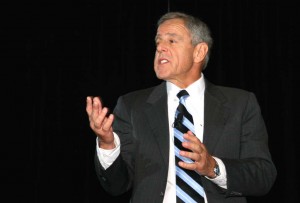
Facing harsh reality: Chrysler's Jim Press
Chrysler is prepared to submit the updated version of its viability plan to its federal overlords, next week, which it hopes will demonstrate that the company not only can survive but actually thrive through the current downturn and beyond, Chrysler Vice Chairman Jim Press says.
“I can tell you we have accepted the fact that there is really is a harsh new reality in the auto industry,” Press said during remarks to the Economic Club of Chicago. “We are confident we have the right plan and we will see Chrysler, again, be a symbol of American innovation and craftsmanship,” he said.
“Everyone in the auto industry is being forced to rethink everything. The good news is that this is also the opportunity to fix a lot of things that should have been fixed a long time ago,” Press asserted.
The former Toyota executive also stressed that Chrysler is already well along in restructuring and repositioning its core business . “When we complete our viability plan, we will have eliminated 1.3 million units of installed capacity, or more than 30 percent, and reduced our fixed cost s by more than $3.8 billion,” he noted.
The cuts also meant the company has eliminated more than 32,000 jobs since Cerberus took control in August, 2007, reducing Chrysler’s total employment to the lowest level since 1934 — when Detroit was still in the depths of the Great Depression — leaving just 64,000 full-time employees. Chrysler has winnowed its lineup and is reducing production of unprofitable models, such as the Viper; it’s in talks with potential buyers that could sustain the high-performance two-seater into the future.
At the same time, the company is prepared to introduce as many as 24 new vehicles, in the next 48 months, even without help from the Italian carmaker Fiat, which is making a bid to establish a global strategic alliance with Chrysler. Press also confirmed, for the first time, that some Fiat models could be produced in Chrysler factories if the deal is sealed.
The company was making progress with suppliers, who have been asked to meet reduced cost targets, and dealers, who have already made significant contributions to the company’s recovery, Press said. The sensitive discussions with outside creditors and the United Auto Workers are still a work in progress, the Chrysler executive noted, sliding by a question about whether the critical agreements with union and creditors would actually be ready by next Tuesday, when the company is scheduled to submit a draft of the viability plan to the government.
Press said Chrysler’s discussions with the Italian carmaker, Fiat, have moved forward. Completion of the negotiations will require final approval of bridge loans from the U.S. government, he said. “Fiat has already said they are not going to touch any of the money from the U.S. government,” he said.
However, if the last section of the federal bridge loan, totaling $3 billion, is approved, he suggested the deal could be concluded by the time the current “non-binding” agreement with Fiat expires at the end of April.
Under the terms of that tentative agreement, Fiat would take a 35 percent stake in Chrysler in exchange for the technology and vehicle platforms the Italian maker promises to provide. “You can’t put a value on what Fiat is offering us,” Press said. “It would take us five or six years to develop what Fiat has.
“The agreement with Fiat will save jobs and accelerate making fuel-efficient cars available for American consumers. What could be better than that,” Press postulated.
Press said Chrysler’s ultimate viability does not depend on concluding a deal with Fiat. Chrysler’s management is fully prepared to demonstrate that it could survive for four years or longer even if industry sales remained at the depressed levels that prevailed during January, when car sales dropped below an annualized rate of just 10 million units per year.
Press also estimated that “between 20 percent and 25 percent of our sales are lost because of credit issues. It doesn’t makes sense to build a high quality, ‘green’ vehicle our dealers can’t stock and our customers can’t get financed,” he said. Making credit available has to be one of the priorities of the new Obama administration.
“Passing the stimulus bill will go a long way toward helping to restore some confidence in the U.S. consumer and the economy,” Press said.
